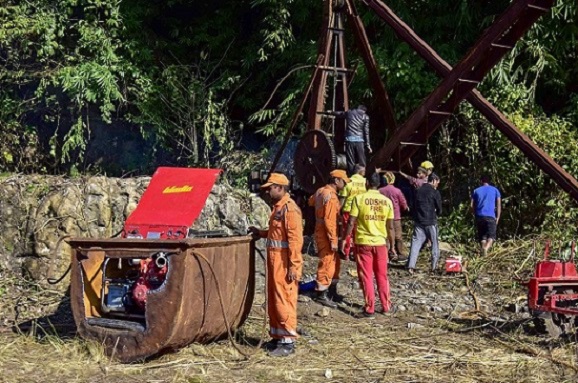
Despite the recent tragedy there seems to be little political inclination and administrative alacrity to ensure that illegal rat-hole coal mining is fully banned in Meghalaya.
The horrific incident in Meghalaya, where 15 miners have been trapped in a rat-hole mine, flooded with water, for more than two-weeks now, is a grave man-made disaster. Equally shocking is to see the reprehensible way it is being handled. Apathetic rescue attempts by the administration, deliberate delay in making arrangements and the insensitive approach of the National media – has reaffirmed the thought that lives of poor people has no value in this country. As already so much time has been wasted, it will be nothing short of a miracle if the 15 miners trapped some 300-odd ft deep in East Jaintia Hills are found alive.
The ghastly incident is an outcome of deadly-mix of several factors – deliberate non-implementation of a judicial judgement, unholy nexus of administration and mine owners, political sentiments against the ban and unavailability of any viable employment opportunities in the region. This prepared the ground which was kept fertile by vested interests for rat-hole mining, which is thriving illegally in Meghalaya.
Human cost of Rat-Hole coal mining
Rat-hole mining is a hazardous method of mining for coal, with tunnels that are only 3-4 feet in diameter, leading to pits ranging 10-300 sq. mt deep. It is hard to believe that such dehumanizing and exploitative form of activity still continues and on such a large scale. There are also reports that, local mine owners have also been using children as labourers in these mines. According to surveys conducted by NGO Impulse, around 70,000 children in the age between 7 to 17 are working in these private mines as casual labor under private contractors without any security to their lives (Impulse: An exploratory study of children engaged in Rat Hole Mining in the coal mines of Jaintia Hills, 2012), many coming from Nepal and Bangladesh. As these coal mines, do not operate under any regulations like the Coal Mines (Nationalisation) Act, no safety arrangements are made for the labourers, who are precariously risking their lives everyday, for a paltry sum of Rs. 500 to 2000.
Environmental cost of mining
Meghalaya has 576.48 million tonnes of coal reserve spread across East Khasi Hills, West Khasi Hills, East Garo Hills, Jaintia Hills and South Garo Hills. The Jaintia Hills, where the incident has occurred, is one of the seven districts of Meghalaya and occupies the eastern part of the state. It is a major coal producing area with an estimated coal reserve of about 40 million tones. Sutnga, Lakadong, Musiang Khliehriat, Ladrymbai, Rymbai, Byrwa are main coal bearing areas of the District. The mining activity has caused severe and permanent environmental degradation in the region. Particularly, unsystematic shallow mining is one of the most important factor water body due to waste dumps. As a result, the National Green Tribunal (NGT) had put a ban on coal mining in April 2014, which has also been upheld by the Supreme Court.
There is little doubt that the Court’s order was never fully implemented, otherwise this tragedy would not have taken place. Another loophole in the judgement that is being exploited with connivance is that the Court has allowed for the transportation of the already extracted coal. Recently, the Supreme Court on December 4 allowed the transportation of an estimated 176,655 tonnes of coal already mined. Miners are taking advantage of this clause and continuing mining more coal. The profitability in mining business is so high that all people’s representatives from this region, whether in state Assembly or in the Parliament, are against the ban. Infact, the six-party-led state government is in favour of an exemption for Meghalaya from the mining laws.
While, the rescue teams, comprising members of the Odisha Fire Service, the National Disaster Response Force (NDRF), the Indian Navy and miners, continue to make efforts to look for the trapped labourers, there seems to be little political inclination and administrative alacrity to ensure illegal mining is fully stopped in the region.
